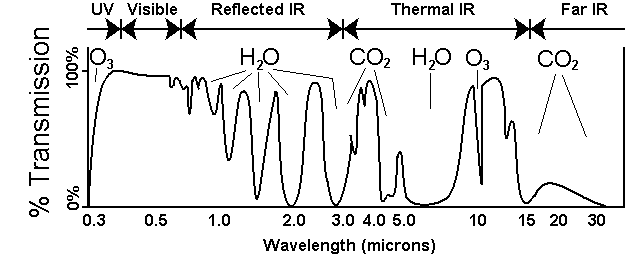Home Sensing Primer Glossary Physics Related Technologies Acknowledgements
Atmospheric windows
Some wavelengths cannot be used in remote sensing because our atmosphere absorbs essentially all the photons at these wavelengths that are produced by the sun. In particular, the molecules of water, carbon dioxide, oxygen, and ozone in our atmosphere block solar radiation. The wavelength ranges in which the atmosphere is transparent are called atmospheric windows. Remote sensing projects must be conducted in wavelengths that occur within atmospheric windows. Outside of these windows, there is simply no radiation from the sun to detect--the atmosphere has blocked it.

The figure above shows the percentage of light transmitted at various
wavelengths from the near ultraviolet to the far infrared, and the sources of atmospheric opacity are also given. You can see that there is
plenty of atmospheric transmission of radiation at 0.5 microns, 2.5 microns, and 3.5 microns, but in contrast there is a great deal of
atmospheric absorption at 2.0, 3.0, and about 7.0 microns. Both passive and active remote sensing technologies
do best if they operate within the atmospheric windows.
There...I think you have reviewed all the essential physics you need to start chatting with remote sensing people without
embarrasing yourself by saying something really foolish. Thrill them!